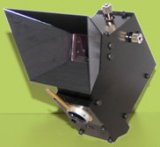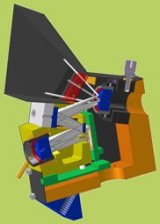Photonics West 2010


from January 26 to 28, 2010 in San Francisco/USA
Booth 4521
Fraunhofer IPMS, Dresden carries out customer specific developments in fields of microelectronic and micro systems technology serving as a business partner that supports the transition of innovative ideas into new products. Fraunhofer IPMS develops and fabricates modern MEMS and OLED devices in its own clean room facilities. In addition to R&D services it offers ramp-up within a pilot production. With modern equipment and about 200 scientists and engineers, the range of projects and expertise covers sensor and actuator systems, microscanner, spatial light modulators, lifetronics as well as organic materials and systems.
At the Photonics West 2010 in San Francisco Fraunhofer IPMS presents:
1. MEMS Spatial Light Modulator Demonstrator
MEMS Spatial Light Modulators (SLMs) are used to modulate the entire cross section of an incident beam of light simultaneously with high spatial resolution. Usually, MEMS thin film technology is used to fabricate an array of micromirrors on top of a CMOS backplane. Each mirror can be addressed and moved individually to control either intensity or phase of one pixel. SLMs are used in a range of applications from video projectors to Adaptive Optics (astronomy, ophthalmology) and mask writers in the semiconductor industry. Contrary to the digitally addressed SLMs in projectors that use time multiplexing to generate grey levels, the SLMs developed by Fraunhofer IPMS are addressed with analogue voltages that enable the chip to directly generate analogue intensities. Micronic Laser Systems ABs mask writers exploit this feature to shift the generated patterns with accuracies far smaller than the system's pixel resolution. The mirrors of the Fraunhofer IPMS device are specified for monochromatic light between 248 nm up to 520 nm, enabling not only the use of the DUV excimer wavelengths, but also the less aggressive (and less costly) near UV light sources. One example where the mirrors could be used is pattern generation for printed circuit boards, but also other areas that require a combination of both, high resolution as well as throughput. The SLM is capable of addressing 1 million pixels at a framerate of 2 kHz (that is, 2 Gpixel/s). The demonstrator setup visualizes the function of the SLM. A green LED generates a light beam, lenses and mirrors guide the light onto the SLM, where it is modulated.
2. MicroScan – a 1D scanner module
Based on its competence in developing and fabrication of micro scanner devices Fraunhofer IPMS presents a 1D micro scanner module. Its modular platform approach was developed to bridge the gap between the supply of bare micro scanner dies and the final integration in the customer application. With the drastic enhancement of the short term availability of OEM-capable customized solutions the institute proofs its competence for packaging, electronics development and system design. The application specific scanner system is based on a modular approach where several prefabricated components are chosen to meet our customers demands.
The complete modular platform consists of:
- A micro scanner device (selected from available devices or even customized fabricated at Fraunhofer IPMS),
- Chip carrier with hermetic housing (optional) and front optics,
- scanning mirror deflection control (optoelectronic sensor),
- Electronics for driving the micro scanner and the deflection sensor with a standard communication interface (SPI) and I/O ports.
A selected module based on the above-described platform is exhibited at Photonics West 2010. This module comprises a 1D micro scanner device mounted on a ceramic substrate housed by a glass dome as optical interface, an optical deflection sensor as well as the miniaturized driving electronics. A modular platform for 2D micro scanners is currently under development and will be available, soon.
3. All-reflective unobscured optical power zoom objective
The Fraunhofer IPMS presents a novel design for an all-reflective unobscured optical power zoom objective. Commercially available lens-based objectives are composed of at least two moveable lenses or lens groups with different complicated moving functions. Using optical elements with variable power (e.g. liquid lenses or deformable mirrors) manufacturing costs can be reduced. Furthermore, because the mechanical guidances become unnecessary, longer product lives can be ensured. However, for applications in the machine vision or in environmental monitoring, where image data over a wide spectral range are required, zoom objectives with liquid lenses are not appropriate. For a lot of applications the UV or near infrared (NIR) part of the light spectrum in combination with the visible light (VIS) is used. Therefore, more than one detector with different spectral sensitivities will be often used. Appling an all-reflective objective without chromatic aberrations instead of a common refractive lens, the need of several objectives will be unnecessary. The all-reflective zoom objective design of the Fraunhofer IPMS consisting of 4 mirrors, which are arranged without any obscuration. The central obscuration of coaxial systems causes a loss of contrast, which can be avoided by a so-called »Schiefspiegler«-approach. The zoom functionality of the objective is realized by changing the curvature of two mirrors. The design provides a zoom factor of 3, a rectangular full field of view between 38° × 49° and 13° × 17°, and an f-number of 4.5. The demonstrator shown at Photonics West proofs the design by three identical systems with different focal lengths, whereas the variable mirrors were substituted by ultraprecision-machined solid mirrors.
4. Lamda – Large aperture MEMS scanner module for 3D distance measurement
Traditional laser scanners for 3D distance measurement involve expensive, heavy and large rotating or vibrating mirrors as a means for light deflection of the scanning TOF (time of flight) distance measurement. Typically, the precision of TOF distance measurements is limited by the amount of signal light available at the detector. Hence, a scanning mirror with large aperture is required for LIDAR systems to collect small amounts of light reflected or scattered by the measured target. Its replacement by a micromechanical scanning mirror device is not straightforward, since a large mirror aperture of the receiver optics must by guaranteed in addition to sufficiently large optical scan angles (> 40°) and high scan frequency of more then 100 Hz. Contrary, the aperture of a single MEMS scanning mirror is limited to small values of typically 1…4 mm diameter due to the dynamic mirror deformation. The Fraunhofer IPMS has developed so far highly miniaturized MEMS scanner devices enabling significant large deflection amplitudes (up to 35°, mechanical) and low power consumption in electrostatic resonant operation, very promising for miniaturized and portable applications. Customized 1D/2D scanner devices are fabricated from single crystalline silicon in a qualified fully CMOS compatible MEMS process suitable for mass fabrication resulting in highly robust and reliable MEMS devices that withstand easily a shock of 2500 g.
Now the Fraunhofer IPMS presents at Photonics West 2010 (San Francisco) the prototype of a new large aperture 1D MEMS scanner module especially designed for laser radar systems. The Lamda module is constructed based on a novel MEMS array of identical scanning mirror elements realized using the flexible MEMS technology of Fraunhofer IPMS. Therefore, Fraunhofer IPMS has designed a scalable MEMS scanner array composed of identical silicon mirror elements with a comparatively large total scanning aperture of 2.51 x 9.51 mm² and a large optical scan range of ± 30°. The 1D MEMS scanner module comprises two separate scanning channels (a) a single scanning mirror of the collimated transmitted beam oscillates parallel to (b) a scanning mirror array of the receiver optics. Light paths of emitting and receiving optics are separated to reduce crosstalk in the final laser radar system. The receiver optics uses an array of 2 x 7 identical mirror elements resulting in a total aperture of 334 mm² and a filling factor of 80%. All mirrors are driven electrostatic resonant at 250 Hz by means of separate in-plane comb drives with identical frequency close to the mechanical resonance for oscillation around their long symmetry axes. Thus, the transmitted beam is sent via a separate emitting master mirror of the same mechanical dimensions as one element of the mirror array. Since laser energy is emitted in only one direction, all the receiving mirrors are synchronized to the master scanner by the driving control electronics to point in the same direction. Hence, the effective apertures of the receiving mirrors add up to form a sufficiently large aperture if all receiving mirrors are synchronized in phase to the emitting master mirror in order to maximize the optical signal of the detector system. To realize the mirror synchronization miniaturized position sensors are integrated into the Lamda module for each individual mirror element. Thus, a precise control of the mirror motion is achieved so that all receiving mirror elements can be slaved to the motion of the emission mirror. The Lamda scanner module has a total size of about 52 x 40 x 40 mm³ and provides a synchronous position signal of the actual scan angle required for the final 3D laser radar system. The MEMS array satisfies at the same time the demand of a comparatively large optically active area, 2.51 x 9.51 mm² per single mirror element, while keeping the resonance frequency of 250 Hz at a value that matches well to current TOF laser distance measurement systems the with point measurement rates of typical 250 - 1000 kHz. Thus, the optical scan range of ±30 degrees is split into 500 - 2000 intervals. The new concept of using an array of synchronized identical MEMS mirror elements for LIDAR systems permits large reception apertures while preserving the outstanding reliability, high scanning speed, compact size and small system weight that can be expected from MEMS. In comparison to systems with conventional scanner components, the new 1D MEMS scanner module enables 3D LIDAR systems to become significantly smaller and more robust. Higher scan rates can be realized without additional efforts (e.g. air bearings). Hence, the Lamda module is very promising for many applications e.g. in security, machine vision and even for portable outdoor use.
 Fraunhofer Institute for Photonic Microsystems
Fraunhofer Institute for Photonic Microsystems